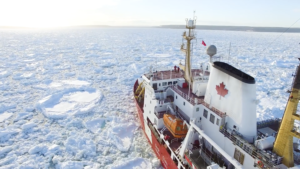Canada’s Inuit seek a larger voice in the future of the Northwest Passage
The waters are seeing growing interest as a shipping route.

As Canada’s Northwest Passage and its nearby resources are eyed with increasing interest by countries such as China, Inuit say they must be included in any discussions about its future use and management.
“Inuit voices are critical to defining the future of the Northwest Passage,” says the Nilliajut 2 report from Inuit Tapiriit Kanatami, released Feb. 2 in Ottawa during the Northern Lights 2018 event. It includes contributions from Inuit in Canada and Greenland.
The report — Nilliajut means “we speak out” — is the second part of a series on Inuit knowledge and opinions, with the first devoted to Inuit perspectives on sovereignty, patriotism and security.
“The need to assert our rights over the Northwest Passage and offshore area has never been greater, nor has the timing been more opportune for Inuit to participate, shape policy and demonstrate our use and occupancy in Arctic waters,” said Mary Simon, a seasoned Inuit politician who has served in the past as the Inuit Circumpolar Council chair and as Canada’s Arctic ambassador.
That call to bring Inuit to the forefront of discussions on the Northwest Passage and be “consulted before any decisions are made and any research is done,” was also echoed by the ICC-Canada’s president and former Liberal MP Nancy Karetak-Lindell, one of the other Inuit authors who contributed to the 84-page report.
“We have to be part of the planning and be at the table to decide what framework will be used to come to decisions and what research will be done and how. This will ensure solid decisions are made that will mitigate changes that we know are coming in the future.” Karetak-Lindell said.
“We cannot turn back the tide, especially on climate change, but we can be better prepared to successfully adapt.”
The former Greenland premier, Kuupik Kleist, one of three commissioners on the Inuit-led Pikialaorsuaq commission on the High Arctic’s north water polynya, also said that “there is an absolute need for Inuit to act now, to take the lead in shaping a new regulatory regime to manage the seas in a sustainable manner.”
“Otherwise the world around is more than ready to take over and once again set the agenda for our lands, seas, and lives.”
Consultant Alfred E.R. Jakobsen, also an executive officer for Oceans North Greenland, was even more straightforward in his comments: “I think Inuit have to be directly involved at the negotiating table under the auspices of the United Nations institutions,” he wrote in Nilliajut 2.
Jakobsen said he supports ITK taking the lead in the discussions, because Inuit in Canada have a lot more at stake than Inuit who live further afield from the Northwest Passage, in Alaska and Greenland.
His recommendations include demands for a mapped shipping corridor in the Northwest Passage, search and rescue facilities along the Northwest Passage and direct Inuit involvement in management and monitoring.
These recommendations dovetail with those from maritime experts who have called for better mapping after disastrous incidents such as the 2010 grounding of the tanker Nanny near Gjoa Haven and that of the cruise ship Clipper Adventurer, whose sight-seeing detour in the Coronation Gulf left it marooned on a shoal east of Kugluktuk.
Others have spelled out the need for better management for shipping and Nunavut consultation on shipping corridors.
The federal government has said it wants to manage the recent increase in Arctic shipping, which has grown by 75 per cent since 2005.
Last August, the federal transport minister, Marc Garneau, headed to Cambridge Bay to announce a $175-million marine safety plan.
Some of that money was earmarked to establish low-impact shipping corridors which could provide infrastructure, navigational support and emergency response services as marine traffic increases in the Arctic.
It’s also paying for a new SAR team based out of Rankin Inlet, where a new inshore rescue station will be located.